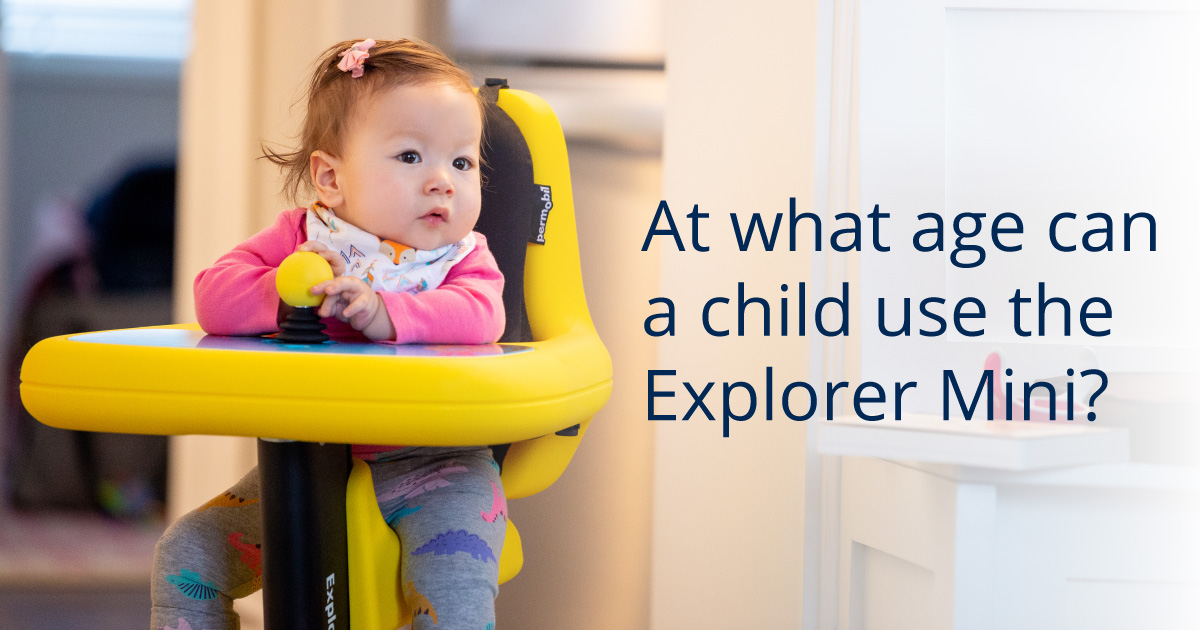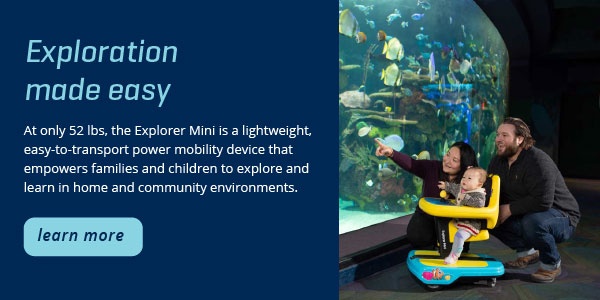Part 3 in our series about developmental milestones in early childhood focusing on mobility. See part 1, part 2, part 4, part 5, part 6, part 7, part 8, part 9, part 10, part 11, and part 12. Learn more about the Explorer Mini here.
The characteristics of the Explorer Mini take into consideration developmental milestones and the hierarchical nature of these achievements.
The 3-5-month-old child begins pre-sitting skills activating the postural support muscles. He draws on earlier achieved skills such as visual fixation, which occurs at 2 months of age, consistent with the onset of propping prone on forearms. The weightbearing that occurs in prone on forearm elicits co-contraction of the gleno-humeral (shoulder) joint muscles which provides the proprioceptive input for joint stability. This promotes upper trunk girdle activation by facilitating the thoracic extensor muscles to engage which in turn encourages head and neck extension.
It is this co-integration of trunk extension with head extension and the visual vestibular interplay that promotes proximal stability

A young child who is able to hold his head upright, or recover head control if temporarily lost, and make postural corrections in a supported sitting position may benefit from use of the Explorer Mini to help promote further development of proximal stability. This allows the other sensory motor skills to gradually integrate. The device is designed for upper extremity weight bearing, like propping up on forearms, that would be a necessary foundation for upper body control. The Explorer Mini provides trunk, pelvis and upper body support to help an infant progress with sitting skills. The infant will be in a position to put weight through the forearms which will promote shoulder joint stability and encourage trunk extension and head control. While the Explorer Mini is designed for 12-36 month old children, the pre-requisite motor skills are compensated for by the inherent support in the design of the sitting and trunk support surfaces (1,2,4,6). In fact, the device is designed to promote sitting by providing a wide base of support and many points of weight bearing, including the feet, the pelvis, the forearms.
Proximal Support and Distal Mobility
Regarding the efficient control of the joystick, the infant with a supported seating posture begins commanding distal motor control once the support or sitting skills are initiated. In other words, one needs proximal support or control to command distal mobility. They are inextricably linked and codependent. You can see this in infants who have mastered independent sitting and are able to manipulate toys with their hands.

Essentially, the postural activation transmits “action plans” to the motor cortex of the brain to control movement of the arms, hands and fingers (4). The multifaceted, multisensory input facilitates motor output. The sensory input mechanisms include somatosensory and proprioceptive systems, weight bearing, kinesthesia (the feeling of movement) and visual cues to align the head and the vestibular system to respond to gravity.
The Explorer Mini is designed to promote the proximal support by providing a wide base of support and many points of weight bearing, including the feet, the pelvis, and the forearms. This support and points of weight bearing promote joint stability, and in the case of the upper extremities, can allow for successful distal mobility and use of the joystick.
The Explorer Mini is designed to provide on-time mobility that supports development. As the goal is not simply getting from point A to point B, the proportional joystick and multiple weight bearing surfaces work in concert to bring about postural control and upper extremity stability required for self-initiated movement.
1. Hadders-Algra, M., Brogren, E., & Forssberg, H. (1996). Training affects the development of postural adjustments in sitting infants. In Journal of Physiology
2. Hadders-Algra, M. (2010) Variation and variability: Key words in human motor development. Physcial Therapy (Vol. 90), Issue 12. https://doi. /10.2522/ptj.20100006
3. Rosen, L., Plummer, T., Sabet, A., Lange, M. L., & Livingstone, R. (2018). RESNA position on the application of power mobility devices for pediatric users. Assistive Technology. https://doi.org/10.1080/10400435.2017.1415575
4. Rosenblum, S., & Josman, N. (2003). The relationship between postural control and fine manual dexterity. Physical and Occupational Therapy in Pediatrics, 23,(4). 47-60.
5. Scheiman, M. (2011). Understanding and managing vision deficits: A guide for occupational therapists (3rd ed.) Thorofare, NJ: SLACK Incorporated.
6. Westcott, S., & Burtner, P. (2004). Postural control in children: Implications for pediatric practice. PT and OT in Pediatrics, 24, 5-55.
 Dr Teresa Plummer, PhD, OTR/L, ATP, CEAS, CAPS
Dr Teresa Plummer, PhD, OTR/L, ATP, CEAS, CAPS
Associate Professor in the School of Occupational Therapy at Belmont University
Dr Teresa Plummer, PhD, OTR/L, ATP, CEAS, CAPS is an Associate Professor in the School of Occupational Therapy at Belmont University in Nashville, TN. She has over 40 yrs of OT experience and 20 in the area of Assistive Technology. She is a member of the International Society of Wheelchair Providers, and the Clinicians Task Force. She is a reviewer for American Journal of OT and guest reviewer for many other journals. She has presented internationally, nationally and regionally particularly in the area of pediatric power mobility. She has authored journal articles and textbook chapters in the area of OT and pediatric mobility and access.

